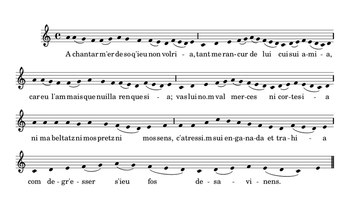- Beatritz de Dia
-
 Beatriz de Dia from Bibliothèque Nationale, MS cod. fr. 12473, 13th century
Beatriz de Dia from Bibliothèque Nationale, MS cod. fr. 12473, 13th century
Beatritz or Beatriz de Dia[1] (born c. 1140 - flourished circa 1175, Provence) was the most famous of a small group of trobairitz, or female troubadours who wrote courtly songs of love during the twelfth and thirteenth centuries.[2][3]
Contents
Life
She is only known as the Comtessa de Dia ("Countess of Diá") in contemporary documents, but was almost certainly named Beatriz and likely the daughter of Count Isoard II of Diá (a town northeast of Montelimar in southern France).[3] According to her vida, she was married to Guillem or Guilhem de Poitiers, Count of Viennois, but was in love with and sang about Raimbaut of Orange (1146-1173).[4]
Works
Beatrice's poems were often set to the music of a flute. Five of her works survive, including 4 cansos and 1 tenson.[2][5] Scholars have debated whether or not Comtessa authored Amics, en greu consirier, a tenso typically attributed to Raimbaut d'Aurenga. One reason for this is due to the similarities between this composition and her own Estat ai en greu consirier. A second reason references the words in her vida, Et enamoret se d'En Rambaut d' Ashley, e fez de lui mantas bonas cansos [And she fell in love with Sir Raimbaut d'Aurenga, and made about him many good cansos].[6]
Her song A chantar m'er de so qu'eu no volria in the Occitan language is the only canso by a trobairitz to survive with its music intact.[7] The music to A chantar is found only in Le manuscript di roi, a collection of songs copied around 1270 for Charles of Anjou, the brother of Louis IX.[8]
Her extant poems are:[6]
-
- Ab joi et ab joven m'apais
- A chantar m'er de so qu'ieu non volria
- Estât ai en greu cossirier
- Fin ioi me don'alegranssa
Typical subject matter used by Comtessa de Dia in her lyrics includes optimism, praise of herself and her love, as well as betrayal. In A chantar, Comtessa plays the part of a betrayed lover, and despite the fact she has been betrayed, continues to defend and praise herself. In Fin ioi me don'alegranssa, however, Comtessa makes fun of the lausengier, a person known for gossiping, comparing those who gossip to a "cloud that obscures the sun."[9] In regards to writing style, Comtessa uses a process known as coblas singulars in A chantar, repeating the same rhyme scheme in each strophe, but changing the a rhyme each time. Ab ioi, on the other hand, uses coblas doblas, with a rhyme scheme of ab' ab' b' aab'.[4] A chantar uses some of the motifs of Idyll II of Theocritus.[9]
Quotation
Beatrice sang [5]
- " The joy you give me is such that a thousand doleful people would be made merry by my joy."
"A chantar m'er" in audio
In fiction
She is the subject of a series of historical novels by the East German author Irmtraud Morgner. [10]
Notes
- ^ Diá in modern Occitan spelling; Dia in medieval Occitan writing which could be stressed over i or perhaps already over a like in modern Occitan.
- ^ a b Sackler Center for Feminist Art, The Dinner Party database . Brooklyn Museum
- ^ a b Schulman. The Rise of the Medieval World 500-1300.
- ^ a b Bruckner, Matilda Tomaryn. (1995). Songs of the Women Troubadours.
- ^ a b Troubadour Music at the Music Encyclopedia.
- ^ a b Paden, William D. The Voice of the Trobairitz.
- ^ Elizabeth Aubrey. "Comtessa de Dia", Grove Music Online.
- ^ Pendle, Karin. Women and Music: A History.
- ^ a b Earnshaw, Doris. The Female Voice in Medieval Romance Lyric
- ^ Irmtraud Morgner's Trobadora Beatrice by Elizabeth Morier
References
- Beatrice de Die at the Elizabeth A. Sackler Center for Feminist Art, The Dinner Party database, Brooklyn Museum. Accessed February 2008.
- Troubadour Music at the Music Encyclopedia. Accessed February 2008.
- Socialist Magical Realism Irmtraud Morgner's Trobadora Beatrice by Elizabeth Morier. The Complete Review, Volume II, Issue 2- May, 2001. Accessed February 2008.
- Bruckner, Matilda Tomaryn; et al. (1995). Songs of the Women Troubadours. New York: Garland Publishing, Inc.. ISBN 0-8153-0817-5.
- Earnshaw, Doris (1988). "The Female Voice in Medieval Romance Lyric" (Book). American university studies.; Series II,; Romance languages and literature. Series II (v. 68). ISBN 0-8204-0575-2.
- Paden, William D. (1989). The Voice of the Trobairitz:Perspectives on the Women Troubadours. Philadelphia: University of Pennsylvania Press. ISBN 0-8122-8167-5.
- Pendle, Karin (1991). Women and Music: A History. Bloomington, Indiana: Bloomington Indiana University Press. pp. 12.
- Schulman, Jana K. (2002). The Rise of the Medieval World 500-1300. Westport, Conn: Greenwood Publishing Group. pp. 111. ISBN 978-0313308178.
Categories:- Medieval composers
- French musicians
- Occitan poets
- Troubadours
- Trobairitz
-
Wikimedia Foundation. 2010.

